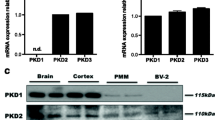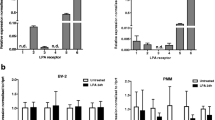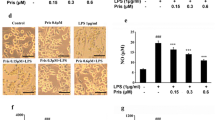Abstract
Lysophosphatidylinositol (LysoPI), an endogenous ligand for G protein-coupled receptor (GPR) 55, has been known to show various functions in several tissues and cells; however, its roles in the central nervous system (CNS) are not well known. In particular, the detailed effects of LysoPI on microglial inflammatory responses remain unknown. Microglia is the immune cell that has important functions in maintaining immune homeostasis of the CNS. In this study, we explored the effects of LysoPI on inflammatory responses using the mouse microglial cell line BV-2, which was stimulated with lipopolysaccharide (LPS), and some results were confirmed also in rat primary microglia. LysoPI was found to reduce LPS-induced nitric oxide (NO) production and inducible NO synthase protein expression without affecting cell viability in BV-2 cells. LysoPI also suppressed intracellular generation of reactive oxygen species both in BV-2 cells and primary microglia and cytokine release in BV-2 cells. In addition, LysoPI treatment decreased phagocytic activity of LPS-stimulated BV-2 cells and primary microglia. The GPR55 antagonist CID16020046 completely inhibited LysoPI-induced downregulation of phagocytosis in BV-2 microglia, but did not affect the LysoPI-induced decrease in NO production. Our results suggest that LysoPI suppresses microglial phagocytosis via a GPR55-dependent pathway and NO production via a GPR55-independent pathway. LysoPI may contribute to neuroprotection in pathological conditions such as brain injury or neurodegenerative diseases, through its suppressive role in the microglial inflammatory response.








Similar content being viewed by others
Abbreviations
- CB2 :
-
Cannabinoid 2
- DAN:
-
2,3-Diaminonaphthalene
- DCF:
-
2′,7′-Dichlorofluorescein
- DMEM:
-
Dulbecco’s modified Eagle medium
- DMSO:
-
Dimethyl sulfoxide
- ERK:
-
Extracellular signal-regulated kinase
- FBS:
-
Fetal bovine serum
- GPR:
-
G protein-coupled receptor
- H2DCFDA:
-
2′,7′-Dichlorodihydrofluorescein diacetate
- IL:
-
Interleukin
- INF-γ:
-
Interferon-γ
- iNOS:
-
Inducible nitric oxide synthase
- LPLs:
-
Lysophospholipids
- LPS:
-
Lipopolysaccharide
- LysoPI:
-
Lysophosphatidylinositol
- MA:
-
Methyl acetate
- MTT:
-
3-(4,5-Dimethyl-2-thiazolyl)-2,5-diphenyl-tetrazolium bromide
- NF-κB:
-
Nuclear factor-kappa B
- NO:
-
Nitric oxide
- ROS:
-
Reactive oxygen species
- TNF-α:
-
Tumor necrosis factor-α
References
Kreutzberg, G.W. 1996. Microglia: a sensor for pathological events in the CNS. Trends in Neurosciences 19: 312–318. https://doi.org/10.1016/0166-2236(96)10049-7.
Nakamura, Y. 2002. Regulating factors for microglial activation. Biological and Pharmaceutical Bulletin 25: 945–953. https://doi.org/10.1248/bpb.25.945.
Block, M.L., L. Zecca, and J. Hong. 2007. Microglia-mediated neurotoxicity: uncovering the molecular mechanisms. Nature Reviews Neuroscience 8: 57–69. https://doi.org/10.1038/nrn2038.
Neniskyte, U., J.J. Neher, and G.C. Brown. 2011. Neuronal death induced by nanomolar amyloid β is mediated by primary phagocytosis of neurons by microglia. Journal of Biological Chemistry 286: 39904–39913. https://doi.org/10.1074/jbc.M111.267583.
Brown, G.C., and A. Vilalta. 2015. How microglia kill neurons. Brain Research 1628: 288–297. https://doi.org/10.1016/j.brainres.2015.08.031.
Aoki, J., Y. Nagai, H. Hosono, K. Inoue, and H. Arai. 2002. Structure and function of phosphatidylserine-specific phospholipase A1. Biochimica et Biophysica Acta 1582 (1–3): 26–32. https://doi.org/10.1016/s1388-1981(02)00134-8.
Alhouayek, M., J. Masquelier, and G.G. Muccioli. 2018. Lysophosphatidylinositols, from cell membrane constituents to GPR55 ligands. Trends in Pharmacological Sciences 39 (6): 586–604. https://doi.org/10.1016/j.tips.2018.02.011.
Grzelczyk, A., and E. Gendaszewska-Darmach. 2013. Novel bioactive glycerol-based lyosphospholipids: new data ― new insight into their function. Biochimie 95: 667–679. https://doi.org/10.1016/j.biochi.2012.10.009.
Kihara, Y., H. Mizuno, and J. Chun. 2015. Lysophospholipid receptors in drug discovery. Experimental Cell Research 333 (2): 171–177. https://doi.org/10.1016/j.yexcr.2014.11.020.
Zhao, C., M.J. Fernandes, G.D. Prestwich, M. Turgeon, J. Di Battista, T. Clair, P.E. Poubelle, and S.G. Bourgoin. 2008. Regulation of lysophosphatidic acid receptor expression and function in human synoviocytes: implications for rheumatoid arthritis? Molecular Pharmacology 73 (2): 587–600. https://doi.org/10.1124/mol.107.038216.
Bektas, M., M.L. Allende, B.G. Lee, W. Chen, M.J. Amar, A.T. Remaley, J.D. Saba, and R.L. Proia. 2010. Sphingosine 1-phosphate lyase deficiency disrupts lipid homeostasis in liver. Journal of Biological Chemistry 285 (14): 10880–10889. https://doi.org/10.1074/jbc.M109.081489.
Vladykovskaya, E., E. Ozhegov, J.D. Hoetker, Z. Xie, Y. Ahmed, J. Suttles, S. Srivastava, A. Bhatnagar, and O.A. Barski. 2011. Reductive metabolism increases the proinflammatory activity of aldehyde phospholipids. Journal of Lipid Research 52 (12): 2209–2225. https://doi.org/10.1194/jlr.M013854.
Hung, N.D., M.R. Kim, and D.E. Sok. 2011. 2-Polyunsaturated acyl lysophosphatidylethanolamine attenuates inflammatory response in zymosan A-induced peritonitis in mice. Lipids 46: 893–906. https://doi.org/10.1007/s11745-011-3589-2.
Nishikawa, M., M. Kurano, H. Ikeda, J. Aoki, and Y. Yatomi. 2015. Lysophosphatidylserine has bilateral effects on macrophages in the pathogenesis of atherosclerosis. Journal of Atherosclerosis and Thrombosis 22 (5): 518–526. https://doi.org/10.5551/jat.25650.
Henstridge, C.M., N.A. Balenga, L.A. Ford, R.A. Ross, M. Waldhoer, and A.J. Irving. 2009. The GPR55 ligand L-α-lysophosphatidylinositol promotes RhoA-dependent Ca2+ signaling and NFAT activation. FASEB Journal 23 (1): 183–193. https://doi.org/10.1096/fj.08-108670.
Anavi-Goffer, S., G. Baillie, A.J. Irving, J. Gertsch, I.R. Greig, R.G. Pertwee, and R.A. Ross. 2011. Modulation of L-α-lysophosphatidylinositol/GPR55 mitogen-activated protein kinase (MAPK) signaling by cannabinoids. Journal of Biological Chemistry 287 (1): 91–104. https://doi.org/10.1074/jbc.M111.296020.
Frasch, S.C., and D.L. Bratton. 2012. Emerging roles for lysophosphatidylserine in resolution of inflammation. Progress in Lipid Research 51 (3): 199–207. https://doi.org/10.1016/j.plipres.2012.03.001.
Kamat, S.S., K. Camara, W.H. Parsons, D.H. Chen, M.M. Dix, T.D. Bird, A.R. Howell, and B.F. Cravatt. 2015. Immunomodulatory lysophosphatidylserines are regulated by ABHD16A and ABHD12 interplay. Nature Chemical Biology 11 (2): 164–171. https://doi.org/10.1038/nchembio.1721.
Wang, X., Y.F. Li, G. Nanayakkara, Y. Shao, B. Liang, L. Cole, W.Y. Yang, X. Li, R. Cueto, J. Yu, H. Wang, and X.F. Yang. 2016. Lysophospholipid receptors, as novel conditional danger receptors and homeostatic receptors modulate inflammation-novel paradigm and therapeutic potential. Journal of Cardiovascular Translational Research 9 (4): 343–359. https://doi.org/10.1007/s12265-016-9700-6.
Celorrio, M., E. Rojo-Bustamante, D. Fernández-Suárez, E. Sáez, A. Estella-Hermoso de Mendoza, C.E. Müller, M.J. Ramírez, J. Oyarzábal, R. Franco, and M.S. Aymerich. 2017. GPR55: a therapeutic target for Parkinson’s disease? Neuropharmacology 125: 319–332. https://doi.org/10.1016/j.neuropharm.2017.08.017.
Haque, M.E., I.S. Kim, M. Jakaria, M. Akther, and D.K. Choi. 2018. Importance of GPCR-mediated microglial activation in Alzheimer’s disease. Frontiers in Cellular Neuroscience 12: 258. https://doi.org/10.3389/fncel.2018.00258.
Oka, S., T. Toshida, K. Maruyama, K. Nakajima, A. Yamashita, and T. Sugiura. 2009. 2-Arachidonoyl-sn-glycero-3-phosphoinositol: a possible natural ligand for GPR55. Journal of Biochemistry 145 (1): 13–20. https://doi.org/10.1093/jb/mvn136.
Pietr, M., E. Kozela, R. Levy, N. Rimmerman, Y.H. Lin, N. Stella, Z. Vogel, and A. Juknat. 2009. Differential changes in GPR55 during microglial cell activation. FEBS Letters 583 (12): 2071–2076. https://doi.org/10.1016/j.febslet.2009.05.028.
Kallendrusch, S., S. Kremzow, M. Nowicki, U. Grabiec, R. Winkelmann, A. Benz, and M. Koch. 2013. The G protein-coupled receptor 55 ligand L-α-lysophosphatidylinositol exerts microglia-dependent neuroprotection after excitotoxic lesion. Glia 61 (11): 1822–1831. https://doi.org/10.1002/glia.22560.
Si, Q., Y. Nakamura, and K. Kataoka. 2000. A serum factor enhances production of nitric oxide and tumor necrosis factor-α from cultured microglia. Experimental Neurology 162 (1): 89–97. https://doi.org/10.1006/exnr.2000.7334.
Horvath, R.J., N. Nutile-McMenemy, M.S. Alkaitis, and J.A. Deleo. 2008. Differential migration, LPS-induced cytokine, chemokine, and NO expression in immortalized BV-2 and HAPI cell lines and primary microglial cultures. Journal of Neurochemistry 107 (2): 557–569. https://doi.org/10.1111/j.1471-4159.2008.05633.x.
de Jong, E.K., A.H. de Haas, N. Brouwer, H.R. van Weering, M. Hensens, I. Bechmann, P. Pratley, E. Wesseling, H.W. Boddeke, and K. Biber. 2008. Expression of CXCL4 in microglia in vitro and in vivo and its possible signaling through CXCR3. Journal of Neurochemistry 105 (5): 1726–1736. https://doi.org/10.1111/j.1471-4159.2008.05267.x.
Kim, Y.L., Y.J. Im, N.C. Ha, and D.S. Im. 2006. Albumin inhibits cytotoxic activity of lysophosphatidylcholine by direct binding. Prostaglandins & Other Lipid Mediators 83 (1-2): 130–138. https://doi.org/10.1016/j.prostaglandins.2006.10.006.
Takano, K., K. Sugita, M. Moriyama, K. Hashida, S. Hibino, T. Choshi, R. Murakami, M. Yamada, H. Suzuki, O. Hori, and Y. Nakamura. 2011. A dibenzoylmethane derivative protects against hydrogen peroxide-induced cell death and inhibits lipopolysaccharide-induced nitric oxide production in cultured rat astrocytes. Journal of Neuroscience Research 89: 955–965. https://doi.org/10.1002/jnr.22617.
Bradford, M.M. 1976. A rapid and sensitive method for the quantitation of microgram quantities of protein utilizing the principle of protein-dye binding. Analytical Biochemistry 72 (1–2): 248–254. https://doi.org/10.1006/abio.1976.9999.
Koyama, Y., Y. Kimura, Y. Yoshioka, D. Wakamatsu, R. Kozaki, H. Hashimoto, T. Matsuda, and A. Baba. 2000. Serum-deprivation induces cell death of rat cultured microglia accompanied with expression of Bax protein. Japanese Journal of Pharmacology 83 (4): 351–354. https://doi.org/10.1254/jjp.83.351.
Hsieh, H.L., and C.M. Yang. 2013. Role of redox signaling in neuroinflammation and neurodegenerative diseases. BioMed Research International 2013: 484613–484618. https://doi.org/10.1155/2013/484613.
Mittal, M., M.R. Siddiqui, K. Tran, S.P. Reddy, and A.B. Malik. 2014. Reactive oxygen species in inflammation and tissue injury. Antioxidants & Redox Signaling 20 (7): 1126–1167. https://doi.org/10.1089/ars.2012.5149.
Qin, L., Y. Liu, T. Wang, S.J. Wei, M.L. Block, B. Wilson, B. Liu, and J.S. Hong. 2004. NADPH oxidase mediates lipopolysaccharide-induced neurotoxicity and proinflammatory gene expression in activated microglia. Journal of Biological Chemistry 279 (2): 1415–1421. https://doi.org/10.1074/jbc.M307657200.
Li, B., K. Bedard, S. Sorce, B. Hinz, M. Dubois-Dauphin, and K.H. Krause. 2009. NOX4 expression in human microglia leads to constitutive generation of reactive oxygen species and to constitutive IL-6 expression. Journal of Innate Immunity 1 (6): 570–581. https://doi.org/10.1159/000235563.
Balenga, N.A., E. Aflaki, J. Kargl, W. Platzer, R. Schröder, S. Blättermann, E. Kostenis, A.J. Brown, A. Heinemann, and M. Waldhoer. 2011. GPR55 regulates cannabinoid 2 receptor-mediated responses in human neutrophils. Cell Research 21 (10): 1452–1469. https://doi.org/10.1038/cr.2011.60.
Li, X., L. Wang, P. Fang, Y. Sun, X. Jiang, H. Wang, and X.F. Yang. 2018. Lysophospholipids induce innate immune transdifferentiation of endothelial cells, resulting in prolonged endothelial activation. Journal of Biological Chemistry 293 (28): 11033–11045. https://doi.org/10.1074/jbc.RA118.002752.
Ginsburg, I., P.A. Ward, and J. Varani. 1989. Lysophosphatides enhance superoxide responses of stimulated human neutrophils. Inflammation 13 (2): 163–174. https://doi.org/10.1007/bf00924787.
Ojala, P.J., T.E. Hirvonen, M. Hermansson, P. Somerharju, and J. Parkkinen. 2007. Acyl chain-dependent effect of lysophosphatidylcholine on human neutrophils. Journal of Leukocyte Biology 82 (6): 1501–1509. https://doi.org/10.1189/jlb.0507292.
Brkić, L., M. Riederer, W.F. Graier, R. Malli, and S. Frank. 2012. Acyl chain-dependent effect of lysophosphatidylcholine on cyclooxygenase (COX)-2 expression in endothelial cells. Atherosclerosis 224 (2): 348–354. https://doi.org/10.1016/j.atherosclerosis.2012.07.038.
Rao, S.P., M. Riederer, M. Lechleitner, M. Hermansson, G. Desoye, S. Hallström, W.F. Graier, and S. Frank. 2013. Acyl chain-dependent effect of lysophosphatidylcholine on endothelium-dependent vasorelaxation. PLoS One 8 (5): e65155. https://doi.org/10.1371/journal.pone.0065155.
Tokizane, K., H. Konishi, K. Makide, H. Kawana, S. Nakamuta, K. Kaibuchi, T. Ohwada, J. Aoki, and H. Kiyama. 2017. Phospholipid localization implies microglial morphology and function via Cdc42 in vitro. Glia 65 (5): 740–755. https://doi.org/10.1002/glia.23123.
Ailte, I., A.B. Lingelem, A.S. Kvalvaag, S. Kavaliauskiene, A. Brech, G. Koster, P.G. Dommersnes, J. Bergan, T. Skotland, and K. Sandvig. 2017. Exogenous lysophospholipids with large head groups perturb clathrin-mediated endocytosis. Traffic 18 (3): 176–191. https://doi.org/10.1111/tra.12468.
Amorós, I., A. Barana, R. Caballero, R. Gómez, L. Osuna, M.P. Lillo, J. Tamargo, and E. Delpón. 2010. Endocannabinoids and cannabinoid analogues block human cardiac Kv4.3 channels in a receptor-independent manner. Journal of Molecular and Cellular Cardiology 48 (1): 201–210. https://doi.org/10.1016/j.yjmcc.2009.07.011.
Bondarenko, A., M. Waldeck-Weiermair, S. Naghdi, M. Poteser, R. Malli, and W.F. Graier. 2010. GPR55-dependent and -independent ion signalling in response to lysophosphatidylinositol in endothelial cells. British Journal of Pharmacology 161 (2): 308–320. https://doi.org/10.1111/j.1476-5381.2010.00744.x.
Bondarenko, A.I., R. Malli, and W.F. Graier. 2011. The GPR55 agonist lysophosphatidylinositol directly activates intermediate-conductance Ca2+-activated K+ channels. Pflügers Archiv: European Journal of Physiology 462 (2): 245–255. https://doi.org/10.1007/s00424-011-0977-7.
Karpińska, O., M. Baranowska-Kuczko, B. Malinowska, M. Kloza, M. Kusaczuk, A. Gęgotek, P. Golec, I. Kasacka, and H. Kozłowska. 2018. Mechanisms of L-alpha-lysophosphatidylinositol-induced relaxation in human pulmonary arteries. Life Sciences 192: 38–45. https://doi.org/10.1016/j.lfs.2017.11.020.
Kaushal, V., P.D. Koeberle, Y. Wang, and L.C. Schlichter. 2007. The Ca2+-activated K+ channel KCNN4/KCa3.1 contributes to microglia activation and nitric oxide-dependent neurodegeneration. The Journal of Neuroscience 27 (1): 234–244. https://doi.org/10.1523/JNEUROSCI.3593-06.2007.
Nguyen, H.M., E.M. Grössinger, M. Horiuchi, K.W. Davis, L.W. Jin, I. Maezawa, and H. Wulff. 2017. Differential Kv1.3, KCa3.1, and Kir2.1 expression in “classically” and “alternatively” activated microglia. Glia 65 (1): 106–121. https://doi.org/10.1002/glia.23078.
Malek, N., K. Popiolek-Barczyk, J. Mika, B. Przewlocka, and K. Starowicz. 2015. Anandamide, acting via CB2 receptors, alleviates LPS-induced neuroinflammation in rat primary microglial cultures. Neural Plasticity 2015: 130639–130610. https://doi.org/10.1155/2015/130639.
Saliba, S.W., H. Jauch, B. Gargouri, A. Keil, T. Hurrle, N. Volz, F. Mohr, M. van der Stelt, S. Bräse, and B.L. Fiebich. 2018. Anti-neuroinflammatory effects of GPR55 antagonists in LPS-activated primary microglial cells. Journal of Neuroinflammation 15 (1): 322. https://doi.org/10.1186/s12974-018-1362-7.
Lieb, K., S. Engels, and B.L. Fiebich. 2003. Inhibition of LPS-induced iNOS and NO synthesis in primary rat microglial cells. Neurochemistry International 42: 131–137. https://doi.org/10.1016/s0197-0186(02)00076-1.
McHugh, D. 2012. GPR18 in microglia: Implications for the CNS and endocannabinoid system signaling. British Journal of Pharmacology 167 (8): 1575–1582. https://doi.org/10.1111/j.1476-5381.2012.02019.x.
Reyes-Resina, I., G. Navarro, D. Aguinaga, E.I. Canela, C.T. Schoeder, M. Załuski, K. Kieć-Kononowicz, C.A. Saura, C.E. Müller, and R. Franco. 2018. Molecular and functional interaction between GPR18 and cannabinoid CB2 G-protein-coupled receptors. Relevance in neurodegenerative diseases. Biochemical Pharmacology 157: 169–179. https://doi.org/10.1016/j.bcp.2018.06.001.
Fu, R., Q. Shen, P. Xu, J.J. Luo, and Y. Tang. 2014. Phagocytosis of microglia in the central nervous system diseases. Molecular Neurobiology 49 (3): 1422–1434. https://doi.org/10.1007/s12035-013-8620-6.
Rinne, P., R. Guillamat-Prats, M. Rami, L. Bindila, L. Ring, L.P. Lyytikäinen, E. Raitoharju, N. Oksala, T. Lehtimäki, C. Weber, E.P.C. van der Vorst, and S. Steffens. 2018. Palmitoylethanolamide promotes a proresolving macrophage phenotype and attenuates atherosclerotic plaque formation. Arteriosclerosis, Thrombosis, and Vascular Biology 38 (11): 2562–2575. https://doi.org/10.1161/ATVBAHA.118.311185.
Balenga, N.A., E. Martínez-Pinilla, J. Kargl, R. Schröder, M. Peinhaupt, W. Platzer, Z. Bálint, M. Zamarbide, I.G. Dopeso-Reyes, A. Ricobaraza, J.M. Pérez-Ortiz, E. Kostenis, M. Waldhoer, A. Heinemann, and R. Franco. 2014. Heteromerization of GPR55 and cannabinoid CB2 receptors modulates signalling. British Journal of Pharmacology 171 (23): 5387–5406. https://doi.org/10.1111/bph.12850.
Moreno, E., C. Andradas, M. Medrano, M.M. Caffarel, E. Pérez-Gómez, S. Blasco-Benito, M. Gómez-Cañas, M.R. Pazos, A.J. Irving, C. Lluís, E.I. Canela, J. Fernández-Ruiz, M. Guzmán, P.J. McCormick, and C. Sánchez. 2014. Targeting CB2-GPR55 receptor heteromers modulates cancer cell signaling. Journal of Biological Chemistry 289 (32): 21960–21972. https://doi.org/10.1074/jbc.M114.561761.
Stella, N. 2009. Endocannabinoid signaling in microglial cells. Neuropharmacology 56 Suppl 1: 244–253. https://doi.org/10.1016/j.neuropharm.2008.07.037.
Mecha, M., F.J. Carrillo-Salinas, A. Feliú, L. Mestre, and C. Guaza. 2016. Microglia activation states and cannabinoid system: therapeutic implications. Pharmacology and Therapeutics 166: 40–55. https://doi.org/10.1016/j.pharmthera.2016.06.011.
Hassan, S., K. Eldeeb, P.J. Millns, A.J. Bennett, S.P. Alexander, and D.A. Kendall. 2014. Cannabidiol enhances microglial phagocytosis via transient receptor potential (TRP) channel activation. British Journal of Pharmacology 171 (9): 2426–2439. https://doi.org/10.1111/bph.12615.
Marichal-Cancino, B.A., A. Fajardo-Valdez, A.E. Ruiz-Contreras, M. Mendez-Díaz, and O. Prospero-García. 2017. Advances in the physiology of GPR55 in the central nervous system. Current Neuropharmacology 15 (5): 771–778. https://doi.org/10.2174/1570159X14666160729155441.
Cooper, C.L., G.H. Jeohn, P. Tobias, and J.S. Hong. 2002. Serum-dependence of LPS-induced neurotoxicity in rat cortical neurons. Annals of the New York Academy of Sciences 962: 306–317. https://doi.org/10.1111/j.1749-6632.2002.tb04076.x.
McHugh, D., S.S. Hu, N. Rimmerman, A. Juknat, Z. Vogel, J.M. Walker, and H.B. Bradshaw. 2010. N-Arachidonoyl glycine, an abundant endogenous lipid, potently drives directed cellular migration through GPR18, the putative abnormal cannabidiol receptor. BMC Neuroscience 11: 44. https://doi.org/10.1186/1471-2202-11-44.
Plastira, I., E. Bernhart, M. Goeritzer, H. Reicher, V.B. Kumble, N. Kogelnik, A. Wintersperger, A. Hammer, S. Schlager, K. Jandl, A. Heinemann, D. Kratky, E. Malle, and W. Sattler. 2016. 1-Oleyl-lysophosphatidic acid (LPA) promotes polarization of BV-2 and primary murine microglia towards an M1-like phenotype. Journal of Neuroinflammation 13 (1): 205. https://doi.org/10.1186/s12974-016-0701-9.
Hill, J.D., V. Zuluaga-Ramirez, S. Gajghate, M. Winfield, and Y. Persidsky. 2018. Activation of GPR55 increases neural stem cell proliferation and promotes early adult hippocampal neurogenesis. British Journal of Pharmacology 175 (16): 3407–3421. https://doi.org/10.1111/bph.14387.
Hill, J.D., V. Zuluaga-Ramirez, S. Gajghate, M. Winfield, U. Sriram, S. Rom, and Y. Persidsky. 2019. Activation of GPR55 induces neuroprotection of hippocampal neurogenesis and immune responses of neural stem cells following chronic, systemic inflammation. Brain, Behavior, and Immunity 76: 165–181. https://doi.org/10.1016/j.bbi.2018.11.017.
Stančić, A., K. Jandl, C. Hasenöhrl, F. Reichmann, G. Marsche, R. Schuligoi, A. Heinemann, M. Storr, and R. Schicho. 2015. The GPR55 antagonist CID16020046 protects against intestinal inflammation. Neurogastroenterology and Motility 27 (10): 1432–1445. https://doi.org/10.1111/nmo.12639.
Brown, A.J., I. Castellano-Pellicena, C.P. Haslam, P.L. Nichols, and S.J. Dowell. 2018. Structure-activity relationship of the GPR55 antagonist, CID16020046. Pharmacology 102 (5–6): 324–331. https://doi.org/10.1159/000493490.
Janefjord, E., J.L. Mååg, B.S. Harvey, and S.D. Smid. 2014. Cannabinoid effects on β amyloid fibril and aggregate formation, neuronal and microglial-activated neurotoxicity in vitro. Cellular and Molecular Neurobiology 34 (1): 31–42. https://doi.org/10.1007/s10571-013-9984-x.
Li, K., J.Y. Feng, Y.Y. Li, B. Yuece, X.H. Lin, L.Y. Yu, Y.N. Li, Y.J. Feng, and M. Storr. 2013. Anti-inflammatory role of cannabidiol and O-1602 in cerulein-induced acute pancreatitis in mice. Pancreas 42 (1): 123–129. https://doi.org/10.1097/MPA.0b013e318259f6f0.
Wei, D., H. Wang, J. Yang, Z. Dai, R. Yang, S. Meng, Y. Li, and X. Lin. 2020. Effects of O-1602 and CBD on TNBS-induced colonic disturbances. Neurogastroenterology and Motility 32 (3): e13756. https://doi.org/10.1111/nmo.13756.
Funding
This work was funded in part by JSPS KAKENHI Grant No. JP18K05999 to Y.N., JP17K15390 to K.T., and JP17K08127 to M.M.
Author information
Authors and Affiliations
Contributions
T.M. and M.M. contributed to the study concept and design, analysis, and drafting of the manuscript. K.T. participated in the data analysis and drafting of the manuscript. Y.N. provided helpful discussion, data interpretation, and manuscript review. All of the authors edited the manuscript and approved the final version.
Corresponding author
Ethics declarations
Conflict of Interest
The authors declare that they have no conflict of interest.
Additional information
Publisher’s Note
Springer Nature remains neutral with regard to jurisdictional claims in published maps and institutional affiliations.
Rights and permissions
About this article
Cite this article
Minamihata, T., Takano, K., Moriyama, M. et al. Lysophosphatidylinositol, an Endogenous Ligand for G Protein-Coupled Receptor 55, Has Anti-inflammatory Effects in Cultured Microglia. Inflammation 43, 1971–1987 (2020). https://doi.org/10.1007/s10753-020-01271-4
Published:
Issue Date:
DOI: https://doi.org/10.1007/s10753-020-01271-4




